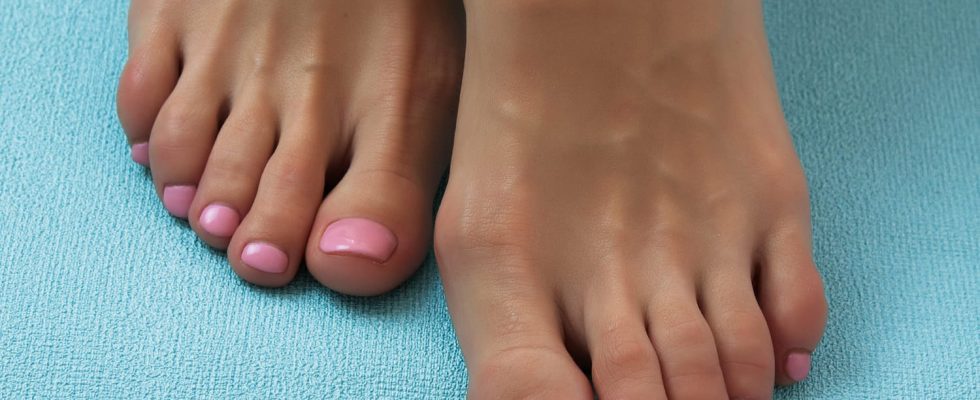Your feet are damaged, they have cracks and are painful? Different causes can be at the origin of dry feet. Solutions and creams to treat dry feet.
The main symptom of dry and damaged feet is thethickening of the stratum corneum, natural process that helps protect the skin of the foot from friction and aggression, this is called horn. The thickening can be very localized at the level of the back of the toes, these are corns, or on the soles of the feet, these are then calluses. While the horn is mostly unsightly, corns and calluses can be very sore and interfere with walking. What are the causes dry feet? What creams to use to treat them?
What causes dry feet?
“These conditions are often caused by repeated traumaTHE friction caused in particular by shoes that are too tight or not wide enough” explains Dr Frédérique Fiszenson-Albala, dermatologist. People with hollow or flat feet who are not equipped with suitable footwear, athletes who do not wear racing soles as well as women accustomed to high heels are frequently subject to it, specifies the specialist. Finally, age is an additional risk factor since osteoarthritis problems or balance disorders aggravate the problem.
What are the risks of dry feet?
Generally benign, Calluses are mostly unsightly. It is nevertheless advisable to bring to the feet an appropriate treatment, for avoid any risk of aggravation. “Untreated, the thickened skin can split, creating painful cracks, fissures and sometimes infections like paronychia” insists Dr. Fiszenson-Albala. It is therefore recommended to consult a doctor if sores appear. Finally, as the specialist points out, “the malposition in the shoes caused by foot pain can be the cause, in a second time, of back pain”.
The treatment of calluses is based on localized care. A keratolytic cream based on urea orsalicylic acid can be offered first. If it is not enough, it may be necessary to consult a podiatrist who will have recourse to their removal using a sharp (scalpel) or rotating object (gouge) to get the tip of the corn.
► Vaseline. Known for its emollient and regenerating properties, Vaseline is an ally of choice in the treatment of dry feet. She can pose all night long, under socks, to soften corns and calluses. When you wake up, warm water and a mild soap will be enough to remove the excess.
► Vegetal oils. Many vegetable oils can be used to moisturize the skin of the feet and soften calluses. This is particularly the case for jojoba, argan, apricot, castor or sweet almond oil. Shea butter and coconut oil, which are solid at room temperature, also give very good results.
► Essential oils. Used in synergy with vegetable oils, certain essential oils are very effective in cleansing the feet and promoting blood circulation. While the carrot and geranium essential oils help regenerate the basal layer of the epidermis, thelavender essential oil relieves irritation and pain.
What creams to use against dry feet?
There is a wide range of callus remover creams available commercially or in pharmacies. They generally associate an agent keratolytic (urea, lactic acid, etc.), a emollienta soothing agent and sometimes a combination of essential oils.
Dry feet and diabetes: what to do?
“In the case of especially unbalanced diabetes, the main fear is that the callus will cause a sore on a bearing areawarns Dr. Fiszenson-Albala. Diabetes-induced neuropathy causes a loss of patient sensitivity who risks not noticing his injury and therefore not treating it. This perforating pain tends to extend in depth (osteo-articular damage) and to more frequent superinfection in the diabetic.” In addition, diabetes also having a deleterious effect on the arteries (neuropathy, arteriopathy), the wound can lead in the worst case to a necrosis (non-perfused area resulting in the death of the perfused tissue).
The best preventative remedy for dry feet and calluses is a regular maintenance by exfoliation and an daily hydration after each shower.
► Sand the stratum corneum lightly and not too often (once a week is enough) can be useful but be careful not to overdo it, because damaged skin can produce more calluses to protect itself.
► Favor the wearing of wide and comfortable shoes, adapted to the shape of the feet.
► Limit the use of high heels.
If the calluses return frequently, it may be useful to make a podiatric check-up to understand the cause (flat foot, hollow, bad posture…) and treat it (soles, orthotics, dressings…).
Thanks to Dr Frédérique Fiszenson-Albala, dermatologist.
